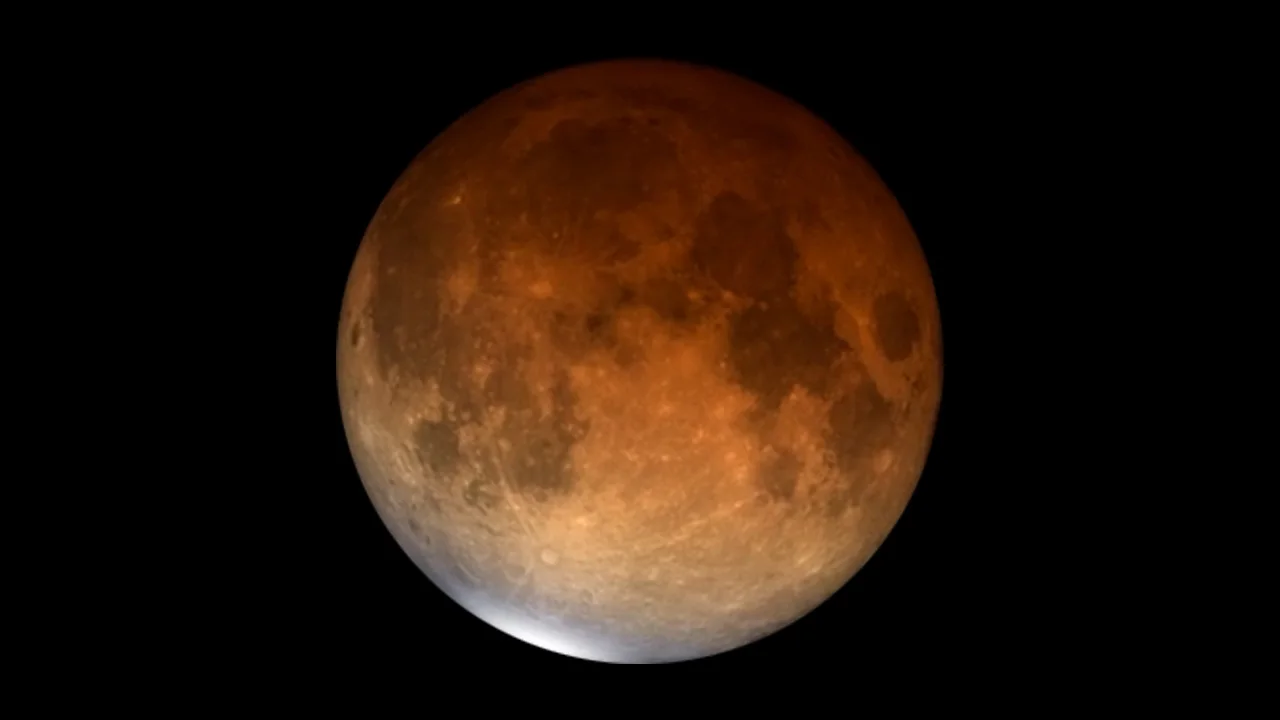
Everything you need to know about November's ultra-rare partial lunar eclipse
November's Full Moon produced the longest partial lunar eclipse seen in centuries.
If you had clear skies Thursday tonight, you were in for a super-rare treat! The Full Moon passed through Earth's shadow, resulting in a partial lunar eclipse unlike anything seen in hundreds of years.
On the night of Thursday, November 18 to Friday, November 19, the Sun, the Earth, and the Moon aligned just right to produce a lunar eclipse. Unlike the Super Blood Flower Moon from earlier this year, the Moon did not turn completely red during this event. Instead, we saw a partial lunar eclipse, where the Moon only mostly dips into the dark red 'umbra' of Earth's shadow.
That shouldn't have deterred anyone though, because it was pretty special!
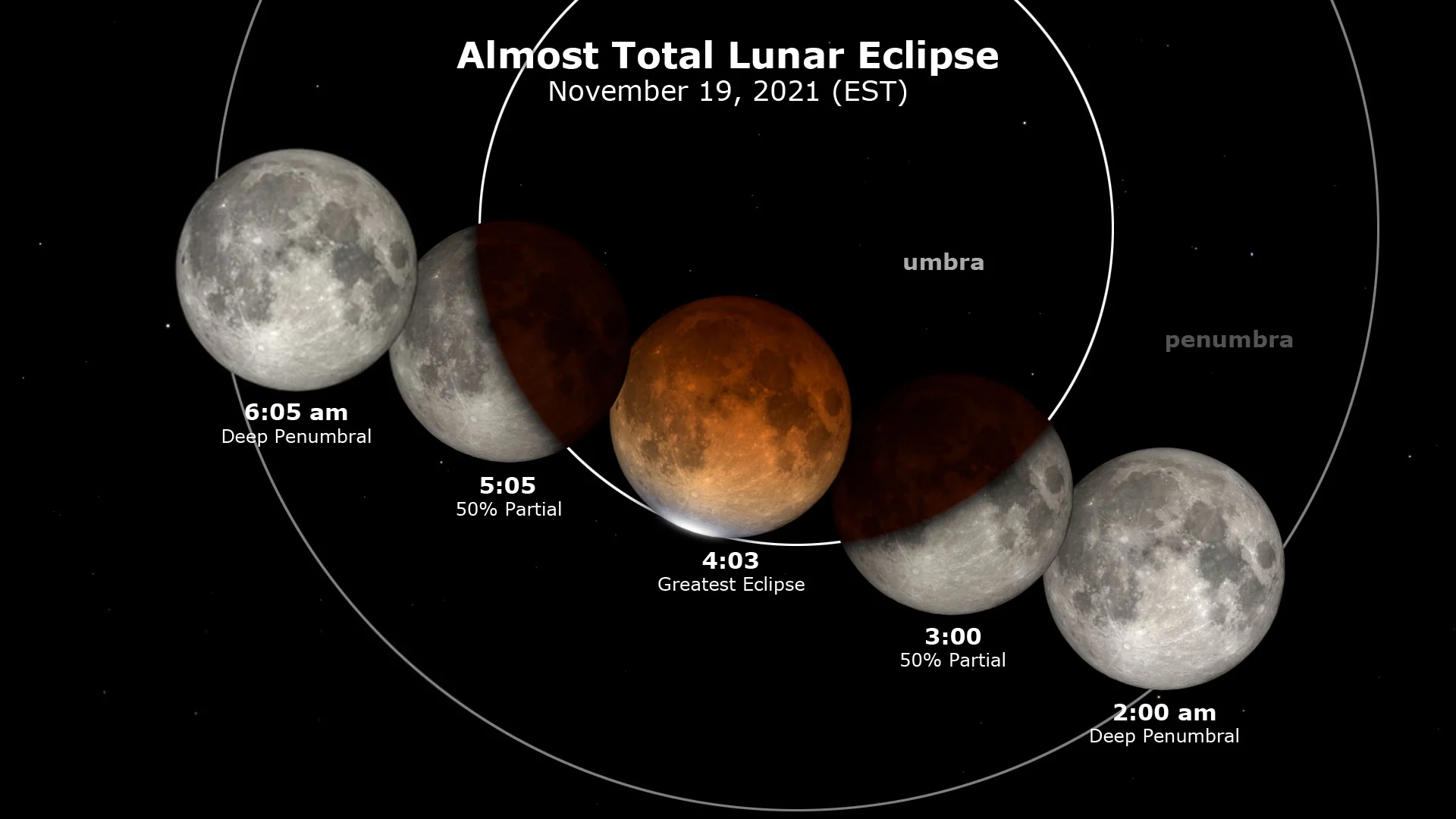
This graphic shows the path of the Moon through Earth's shadow on the night of Thursday, November 18 through Friday, November 19. The times referenced in the graphic are in Eastern Standard Time. Credit: NASA SVS/Scott Sutherland
As the eclipse occurred, starting at just after 1 a.m. EST on Friday morning (2:30 a.m. NST/10 p.m. PST, Thursday night), the Moon's path plunged it nearly all the way into the deepest, darkest part of Earth's shadow — the umbra. At the moment of greatest eclipse, about 3 hours after the event began, only a tiny sliver of the Moon's south polar region remained in the faint penumbra.
So, this was about as close to a total lunar eclipse as you could get, without it actually being a total lunar eclipse!
WHO SAW IT?
Whether you have access to the darkest rural skies or you are under the light pollution dome of a sprawling urban centre, the brightness of the Moon allows everyone a chance of viewing a lunar eclipse.
The key factors for who actually gets to see it, though, are the timing, and how clear or cloudy the sky is during the event.

This map shows cloud cover across Canada and most of the United States, as captured by the GOES-16 geostationary weather satellite at 9 UTC (4 a.m. EST), just before the peak of the November 18-19 partial lunar eclipse. Credit: CIRA/NOAA
Due to cloud cover, southern Ontario, southern Quebec, central Saskatchewan, and central Alberta were the best places across Canada for viewing.
If you found yourself stuck under cloudy skies, read on for details on how you can watch it, even now, after the event!
More: See what others saw during this super-rare lunar eclipse
WHEN DID IT HAPPEN?
The timing of this "almost total" lunar eclipse made it visible to everyone across Canada and the United States (weather permitting).
Because the eclipse happened simultaneously for everyone, though, time zones needed to be taken into consideration during the event. Thus, the challenging part was that the farther east you were, the later you needed to stay awake or the earlier you needed to get up to see it.
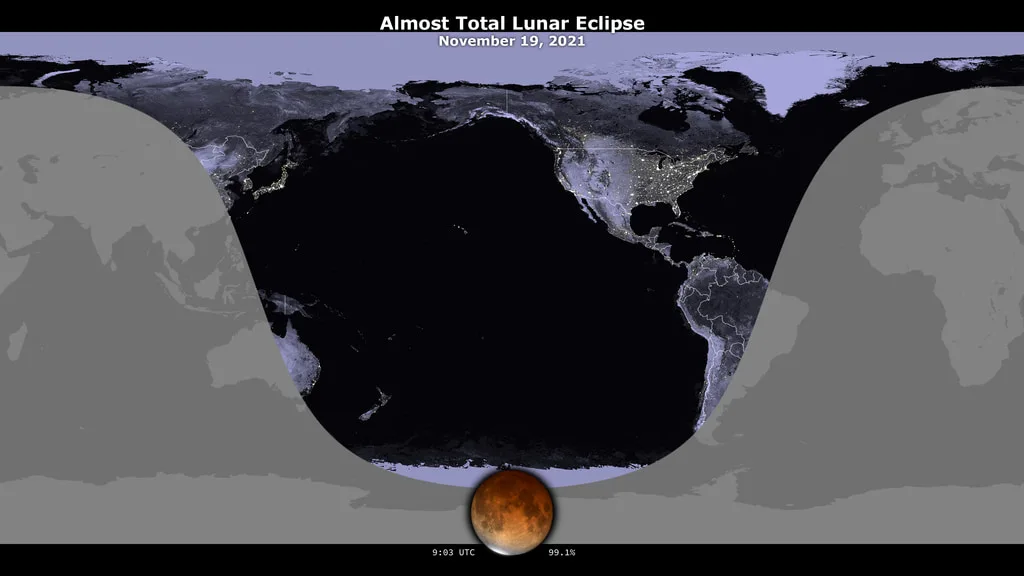
The visibility of the November 18-19 lunar eclipse includes all of Canada. Only parts of eastern Canada missed the very end of the penumbral eclipse as the Sun rose in the morning. Credit: NASA's Scientific Visualization Studio
Listed below are the eclipse times for each time zone across Canada, starting with the entire duration of the eclipse, then that of the partial eclipse, and the time of greatest eclipse.
NST — 2:32 a.m.-8:33 a.m.; Partial 3:48 a.m.-7:17 a.m.; Greatest 5:33 a.m.
AST — 2:02 a.m.-8:03 a.m.; Partial 3:18 a.m.-6:47 a.m.; Greatest 5:03 a.m.
EST — 1:02 a.m.-7:03 a.m.; Partial 2:18 a.m.-5:47 am; Greatest 4:03 a.m.
CST — 2:02 a.m.-6:03 a.m.; Partial 1:18 a.m.-4:47 a.m.; Greatest 3:03 a.m.
MST — 11:02 p.m.-5:03 a.m.; Partial 12:18 a.m.-3:47 am; Greatest 2:03 a.m.
PST — 10:02 p.m.-4:03 a.m.; Partial 11:18 p.m.-2:47 a.m.; Greatest 1:03 a.m.
The entire eclipse lasted for 6 hours and 1 minute, from beginning to end. For the first hour and 15 minutes or so, it would have been challenging to notice the effects as the Moon entered the faint penumbra. After that, though, the partial phase of the eclipse began. This was the good part, when the dark umbra crept across the face of the Moon!
The characteristic reddish tinge of the umbra may not have been noticeable for the first while, as our eyes struggled with the contrast between the dark lunar surface in the umbra and the brighter part that was still in the penumbra. The colour become more apparent as time passed, though, and closer to the point of greatest eclipse, there was some hope that we'd be treated to a fantastic sight.
A SPLASH OF COLOUR
During a total lunar eclipse, when only a tiny portion of the Moon is peaking out of the umbra, close observers often notice bands of colour spread out across the Moon's face. This becomes even more noticeable through a telescope, a pair of binoculars, or through a camera using a telephoto lens.
This array of colours is known as the Japanese Lantern Effect.
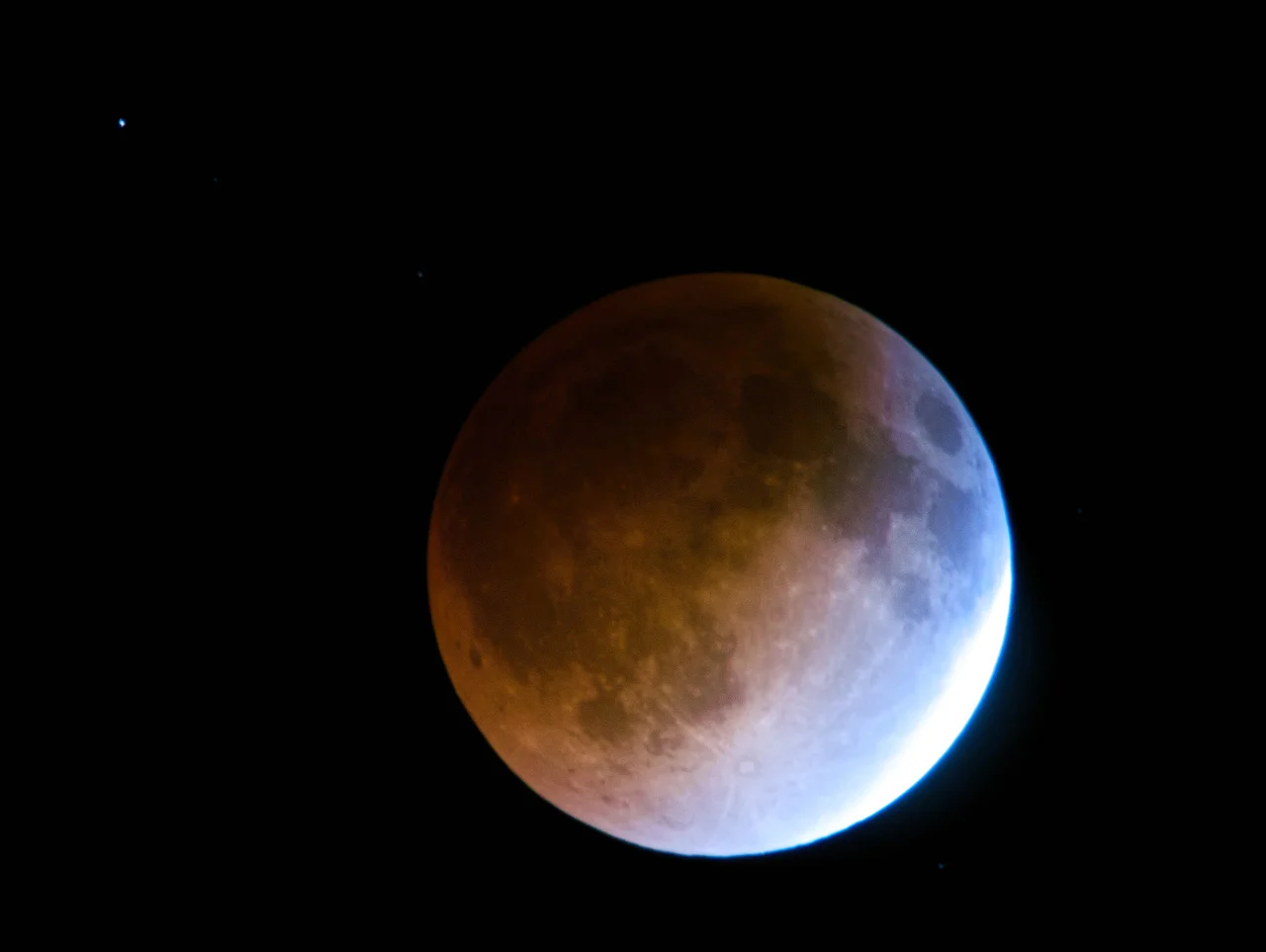
This photograph, taken from New Braunfels, Texas, during the April 15, 2014 total lunar eclipse, shows the Moon just before it was completely immersed in the umbra. Credit: Larry Johnson/Wikimedia Commons (CC by 2.0)
The term was apparently coined in the 1950s by astrophotographer Peter A. Leavens. It describes the stages of a total lunar eclipse that starts roughly five minutes before totality and again for approximately five minutes after totality ends.
The outer part of Earth's shadow (the penumbra) is usually portrayed as gray, and the inner part (the umbra) is shown as red. However, a much more subtle array of colours go into both. This is due to light filtering through the different layers of Earth's atmosphere. These subtle colours become more noticeable as more of the umbra darkens the Moon's surface, although seeing them usually requires the use of a telescope or longer-exposure image, to gather the maximum amount of light from the Moon.
While this effect is seen for only a short time during a total lunar eclipse, we may see it for close to an hour during Thursday's partial lunar eclipse!
Read More: What else is going on in the Night Sky this Fall?
LONGEST PARTIAL LUNAR ECLIPSE IN CENTURIES
At 3 hours, 28 minutes and 24 seconds long, Thursday night's partial lunar eclipse was the longest seen this century.
For comparison, this century's shortest total lunar eclipse is on April 4, 2015, spent precisely 3 hours and 29 minutes passing through the umbra. The Moon was so close to the umbra's edge during that event that some observers who were closely watching with telescopes actually questioned if it genuinely qualified as a total lunar eclipse!
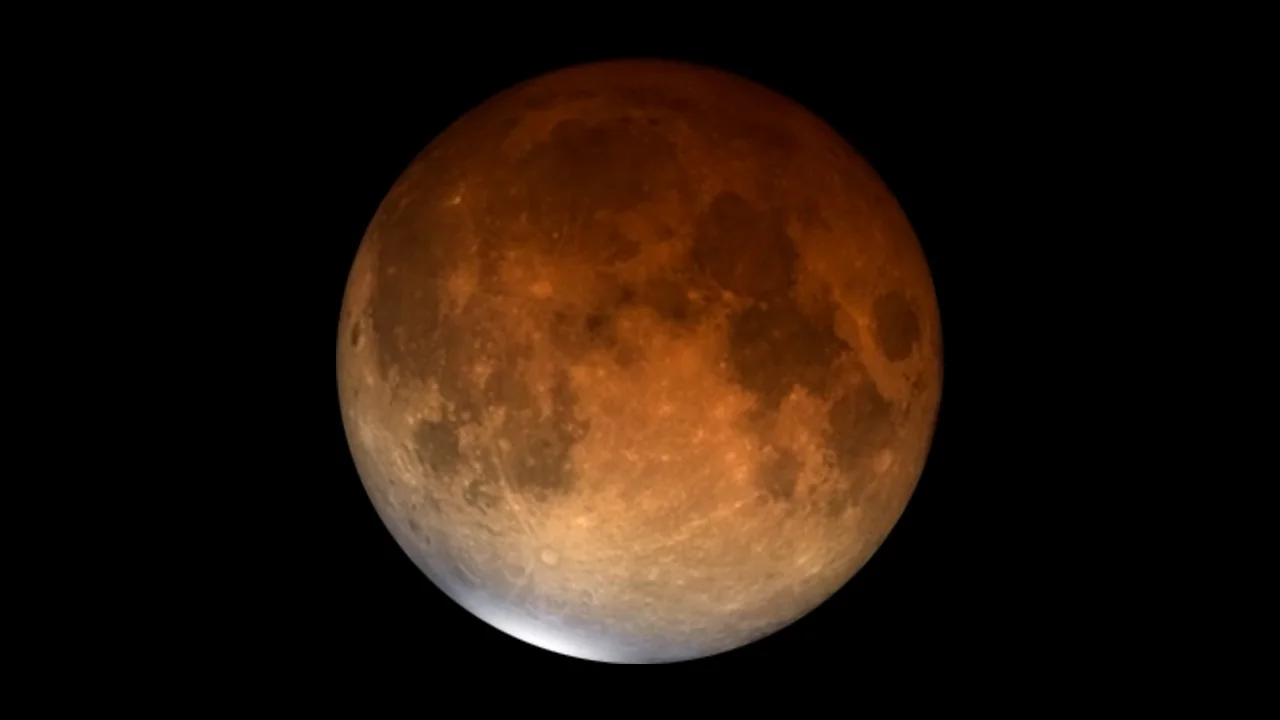
This simulated view of the Moon shows what the November 18-19 Partial Lunar Eclipse looked like at greatest eclipse. Credit: NASA SVS/Scott Sutherland
Thursday night's eclipse wasn't just the longest partial lunar eclipse of this century, though. In fact, it was the longest eclipse seen in over five centuries past, and it's the longest in more than six centuries going forward!
According to NASA's records, the last "longest partial lunar eclipse" — at 3 hours, 28 minutes, and 48 seconds long — took place over 581 years ago, on February 18, 1440! For the next one, which will be an even 3 hours and 30 minutes long, there's an even longer wait! It occurs nearly 648 years from now, on February 8, 2669!
So, this was one not to be missed!
WATCH FROM ANYWHERE!
For those who were stuck under clouds on Thursday night, or had to wait until after the event to watch, there were several live views of the eclipse streaming on the internet.
The famousGriffith Observatory hosted one from their location in Los Angeles, California. The Lowell Observatory presented their own stream from Flagstaff, Arizona.
The live stream from timeanddate.com, is probably the best one available, though, as it provided views from different parts of the world, and thus it bypassed any potential interference from the weather.
So, if you couldn't witness this one for yourself or watch it live on the web as it was happening, you don't have to completely miss out on seeing this extremely rare eclipse.
